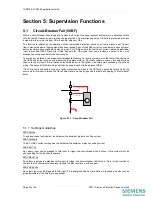
7SR210 & 7SR220 Applications Guide
2.9
Negative Phase Sequence Overcurrent (46NPS)
The presence of Negative Phase Sequence (NPS) current indicates an unbalance in the phase currents, either
due to a fault or unbalanced load.
NPS current presents a major problem for 3-phase rotating plant. It produces a reaction magnetic field which
rotates in the opposite direction, and at twice the frequency, to the main field created by the DC excitation system.
This induces double-frequency currents into the rotor which cause very large eddy currents in the rotor body. The
resulting heating of the rotor can be severe and is proportional to (I
2
)
2
t.
Generators and Motors are designed, manufactured and tested to be capable of withstanding unbalanced current
for specified limits. Their withstand is specified in two parts; continuous capability based on a figure of I
2
, and
short time capability based on a constant, K, where K = (I
2
)
2
t. NPS overcurrent protection is therefore configured
to match these two plant characteristics.
2.10 Undercurrent (37)
Undercurrent elements are used in control logic schemes such as Auto-Changeover Schemes, Auto-Switching
Interlock and Loss of Load. They are used to indicate that current has ceased to flow or that a low load situation
exists. For this reason simple Definite Time Lag (DTL) elements may be used.
For example, once it has been determined that fault current has been broken – the CB is open and no current
flows – an auto-isolation sequence may safely be initiated.
2.11 Thermal Overload (49)
The element uses measured 3-phase current to estimate the real-time Thermal State,
θ
, of cables or
transformers. The Thermal State is based on both past and present current levels.
θ
= 0% for unheated equipment, and
θ
= 100% for maximum thermal withstand of equipment or the Trip
threshold.
Figure 2.11-1 Thermal Overload Heating and Cooling Characteristic
For given current level, the Thermal State will ramp up over time until Thermal Equilibrium is reached when
Heating Effects of Current = Thermal Losses.
The heating / cooling curve is primarily dependant upon the Thermal Time Constant. This must be matched
against that quoted for the item of plant being protected. Similarly the current tripping threshold,
, is related to
the thermal withstand of the plant.
θ
I
Thermal Overload is a slow acting protection, detecting faults or system conditions too small to pick-up fast acting
protections such as Phase Overcurrent. An Alarm is provided for
θ
at or above a set % of capacity to indicate that
a potential trip condition exists and that the system should be scrutinised for abnormalities.
Page 24 of 40
©2011 Siemens Protection Devices Limited






























